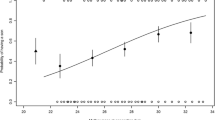Summary
Body size in the field cricket,Gryllus bimaculatus, contributes to fitness through its effects on competitive male mating success and female fecundity and is a character chosen by females at mating. If females are to benefit from preferentially mating with large males they must be able to pass on the advantages of large size to their offspring. The heritabilities of four aspects of body size were estimated by parent-offspring regression. All aspects were shown to have heritable genetic variation despite the fact that theory predicts characters which contribute to fitness should not be heritable. There may therefore be the potential for female choice in this species to be adaptive. Some possible mechanisms for the maintenance of heritable variation are discussed.
Similar content being viewed by others

References
Arnold SJ (1983) Sexual selection: the interface of theory and empiricism. In: Bateson P (ed) Mate choice. Cambridge University Press, Cambridge, pp 67–107
Bateson P (1983) Optimal outbreeding. In: Bateson P (ed) Mate choice, Cambridge University Press, pp 257–277
Berry RJ (1977) Inheritance and natural selection. Collins, London
Borgia G (1979) Sexual selection and the evolution of mating systems. In: Blum MS, Blum NA (eds) Sexual selection and reproductive competition in insects. Academic Press, London, pp 19–80
Borgia G (1981) Mate selection in the flyScatophaga stercororia: female choice in a male controlled system. Anim Behav 29:71–80
Burley N (1981) Mate choice by multiple criteria in a monogomous species. Am Nat 117:515–526
Cade W (1984) Genetic variation underlying sexual behaviour and reproduction. Am Zool 24:355–366
Collins NC (1980) Developmental responses to food limitation as indicators of environmental conditions forEphydra cinerea Jones. Ecology 61:650–661
Dingle H, Brown CK, Hegmann JP (1977) The nature of genetic variance influencing photoperiodic diapause in a migrant insect,Oncopeltus fasciatus. Am Nat 111:1047–1059
Falconer DS (1963) Quantitative inheritance. In: Burdette WJ (ed) Methodology in mammalian genetics. Holden-Day, San Francisco, pp 193–216
Falconer DS (1973) Replicated selection for body weight in mice. Genet Res 22:291–321
Falconer DS (1981) Introduction to quantitative genetics, 2nd ed. Longman, London
Fisher RA (1930) The genetic theory of natural selection, 2nd ed. Oxford University Press, Oxford
Grant JWA, Colgan PW (1983) Reproductive success and mate choice in the Johnny Darter (Etheostoma nigrum) (Pisces: Percidae). Can J Zool 61:437–446
Gwynne DT (1984) Courtship feeding increases female reproductive success in bush crickets. Nature 307:361–363
Howard RD (1978) The evolution of mating strategies in bull-frogs,Rana catesbeiana. Evolution 32:850–871
Istock CA (1978) Fitness variation in a natural population. In: Dingle H (ed) Evolution of insect migration and diapause. pp 171–190. Springer, Berlin Heidelberg New York
Istock CA (1983) The extent and consequences of heritable variation for fitness characters. In: King CE, Dawson PS (eds) Population biology: retrospect and prospect. Columbia University Press, Columbia, pp 61–96
Jones JS (1987) The heritability of fitness: bad news for “good genes”? TREE 2(2):35–38
Kempthorne O, Tandon OB (1953) The estimation of heritability by regression of offspring on parents. Biometrics 9:90–100
Kodric-Brown A (1983) Determinants of male reproductive success in pupfish (Cyprinoden pecesensis). Anim Behav 31:128–137
Lande R (1976) The maintenance of genetic variability by mutation in a polygenic character with linked loci. Genet Res 26:221–235
Lande R (1982) A quantitative genetic theory of life history evolution. Ecology 63:607–615
Lush JL (1949) Heritability of quantitative characters in farm animals. Hereditas suppl vol:356–375
Mackay TFC (1986) A quantitative genetic analysis of fitness and its components inDrosophila melanogaster. Genet Res 47:59–70
Maynard Smith J (1978) The evolution of sex. Cambridge University Press, Cambridge
Meats A (1971) The relative importance to population increase of fluctuations in mortality, fecundity and the time variable of the reproductive schedule. Oecologia (Berlin) 6:223–237
Nisbet ICT (1973) Courtship feeding, egg size and breeding success in common terns. Nature 241:141–142
Palmer JO, Dingle H (1976) Direct and correlated responses to selection among life-history traits in milkweed bugs (Oncopeltus fasciatus). Evolution 40:767–777
Partridge L (1983) Non-random mating and offspring fitness. In: Bateson P (ed) Mate choice. Cambridge University Press, Cambridge, pp 227–255
Plomin R, DeFries JC, McClearn GE (1980). Behavioural genetics: a primer. Freeman, San Francisco
Frout T (1971) The relation between fitness components and population prediction inDrosophila. I. The estimation of fitness components. Genetics 68:127–147
Robertson A (1955) Selection in animals: synthesis. Cold Spr Harb Symp Quart Biol 20:225–229
Rose MR (1982) Antagonistic pleiotropy, dominance and genetic variation. Heredity 48:63–78
Simmons LW (1986a) Intermale competition and mating success in the field cricket,Gryllus bimaculatus (De Geer). Anim Behav 34:567–579
Simmons LW (1986b) Sexual selection in the field cricket,Gryllus bimaculatus (De Geer). Ph D thesis, University of Nottingham
Simmons LW (1986c) Female choice in the field cricket,Gryllus bimaculatus (De Geer). Anim Behav 34:1463–1470
Simmons LW (1987) Competition between larvae of the field cricketGryllus bimaculatus (Orthoptera: Gryllidae) and its effects on some life-history components of fitness. J Anim Ecol (in press)
Sigurjonsdottir H (1984) Food competition amongScatophaga sterocoraria larvae with emphasis on its effects on reproductive success. Ecol Entomol 9:81–90
Smith RH, Sibly RM, Moller H (1987) Control of size and fecundity inPieris rapae: towards a theory of butterfly life cycles. J Anim Ecol 56:341–350
Springer P, Boggs CL (1986) Resource allocation to oocytes: heritable variation with altitude inColias philodice eriphyle (Lepidoptera). Am Nat 127:252–256
Thornhill R (1976) Sexual selection and nuptial feeding behaviour inBittacus apicalis (Insecta: Mecoptera). Am Nat 110:529–548
Vehrencamp SL, Bradbury JW (1984) Mating systems and ecology. In: Krebs JR, Davies NB (eds) Behavioural ecology: an evolutionary approach. Blackwell, London
Zimmerman JL (1966) Polygyny in the dickcissel. Auk 83:534–546
Author information
Authors and Affiliations
Rights and permissions
About this article
Cite this article
Simmons, L.W. Heritability of a male character chosen by females of the field cricket,Gryllus bimaculatus . Behav Ecol Sociobiol 21, 129–133 (1987). https://doi.org/10.1007/BF02395441
Received:
Accepted:
Issue Date:
DOI: https://doi.org/10.1007/BF02395441



